Posts Tagged ‘Chickens’
Farm Census
I was thinking about the census the other day, and thought it would be interesting (for you all) to read a census of my little homestead. I’m a huge proponent of doing what you can where you can. No matter how big or how small you think you’re place is there is always room for a bit of self-sufficiency.
Homestead Census 2010
5 – lambs
18 – chickens
1 – rabbit
6 – blueberries
7 – berries (1 black, 1 Logan, 1 red rasp, 4 yellow rasp)
6 – fruit trees
8 – 4’x8’ raised veggie beds
3 – 8’x10’ raised beds
2 – mangy mutts (just kidding)
1 – active kid, and
1 – tired mom
Tricks to Peeling Fresh Hard Boiled Eggs
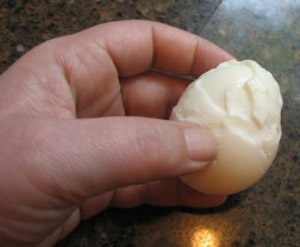
With all kinds of people raising their own chickens these days and more people buying fresh eggs at local farmers markets you knew there had to be a downside to this picture perfect farm product, didn’t ya?
Well, there is.
And, I was reminded of it this afternoon when I went to make myself lunch – fresh, homemade egg salad. Sometimes it seems nearly impossible to peel a fresh egg so that it looks good enough to use for anything other than what requires chopped eggs.
As you can see from the photograph above–they turn out looking like craggy moonscapes or postmarked, unsightly and just plain old ugly.
Standing there looking out the kitchen window trying in vain to peel the eggs I needed for my lunch, I chuckled to myself, remembering the battles my dad had using fresh eggs for his much-loved deviled eggs. It also reminded me of dad’s solution:
When he planned to make a dish that required pristine perfect hardboiled eggs, like for deviled eggs, he would set aside the number of eggs he needed a week or so in advance. Older eggs peel more easily, mainly because the air pocket inside the egg grows larger. As eggs age, the membrane of the egg doesn’t cling as tightly, allowing nimble-fingers to peel up a well-crackled shell by picking at a bit of membrane and zipping everything off in two or three swipes.
But, if dad was in a hurry, or just couldn’t wait to make deviled eggs, forcing him to use fresh eggs, it was hard to make them look as pristine as the older ones, and so, although they tasted great they never looked anything like ones made with older eggs.
If you can’t wait to use your homegrown eggs either try these tips for peeling fresh eggs. But remember – no matter how careful you are, fresh eggs are hard to peel and may not come out perfect every time.
Set eggs out so they come to room temperature; place in a pot and fill with water so you have at least 2-inches of water covering the eggs. Place on stove over medium-high heat until water comes to a full boil. Take pan off stove, cover and set aside for 12 to 15 minutes (18 minutes for extra large eggs). The hot water will continue to cook the eggs.
When the time is up, drain off the water and replace with cold water. If the water reheats, drain and refill again. (Remember to recycle the water in the garden or on potted plants.)
Once the eggs have cooled completely, gently tap the large end of the egg against a hard surface like your kitchen counter. This should crack the shell.
Turn the egg and crack the other end, then gently crack the shell all the way around. The shell should peel off easily at this point.
Here’s another…
Follow the cooking instructions above. When eggs are finished cooling gently crack them on the side of a pan or the counter. Find the membrane that lies between the cooked egg and the shell. Here’s the key…gently pull off the shell with the membrane sliding your thumb along the smooth shiny cooked egg, bringing the membrane and shell off together so that it doesn’t bring the cooked egg white off with the shell.
And another…
Once the eggs are cooked, drain the water. Shake the pan violently so the eggs crack into tiny pieces on all sides. Fill the pan with very cold water and let stand for several minutes. At this point the shell should come right off after you get it started.
Hard boiled eggs in the shell can be refrigerated up to one week. Hard boiled eggs out of the shell should be used right away.
Take the First Step
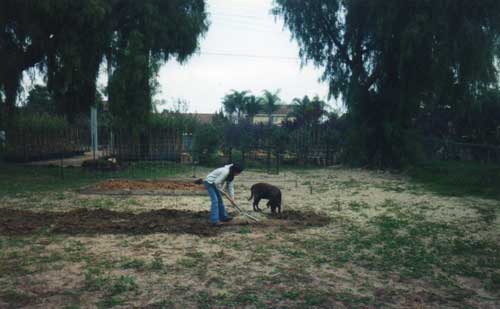
I found this photo from the first year here on our little suburban homestead. It was taken after my friend Rouge came over to grade and level the property, making the water drain properly. We had already removed about a dozen old, scraggy, ill cared for fruit trees that were planted haphazardly around the property, mangy Oleander bushes and a row of boxwood hedge that divided the property in half.
The photo is nothing special, just Brianne helping trench the barn waterline, raised beds and stakes outlining the footprint of the barn. But what it has lead to is six years of a working, prosperous backyard farm. In just a few years after this photo was taken we have built the barn (by hand) that now houses our livestock, planted gardens, bred rabbits, raised sheep, kept chickens, lived with mutts (Dakota and Dutch), danced to music at sunset, raised a kid and fell in love with the simpler things in life.
There were many times I had no idea what the hell I was doing; I taught myself as I went along, reading books in Borders over a steaming bowl of soup at lunch. I scoured the internet for forums of like-minded people. I joined clubs, made new friends, tapped old ones for information and techniques. We learned to eat from dirt and farm stands. We mostly eat at home now, but we go out to get what we need; out to the garden that is, to pick veggies and fruit and eggs. I can quilt now, build what I need, bake our own bread and sit down to share it all with you. But, the point I want to make is that things grew from the first small effort, and with steps taken it will bring you home.
Here we are today, with a freezer full of home grown lamb and chicken, handmade sausage and salami, berries, tomatoes, beans and peas. We get almost a dozen eggs a day. We’ve just hatched our own chicks – again. I know how to butcher a chicken from first cut to final wrap. I’m learning to collect rain water. Every year we learn and grow, becoming more self-sufficient thanks to this land.
A lot can happen if you make it. And it all starts somewhere. As the saying goes, “the journey of a thousand miles begins with the first step”. If you need proof, just look at the picture again. What was once barren, dry, and brown is lush and green and fruitful.
Make today the beginning of your journey. Just take that first step.
Foggy Morning, Sleeping Dogs
It’s a cold, foggy morning here on the farm. In a few minutes Brianne will be outside in the dusky morning feeding chickens and rabbits and sheep by the dim light of dawn, but right now I’m putting on the teapot and waking up the dogs. Dutch and Dakota are still curled up on their beds, not the least bit interested in my morning routine. I think they know it’s foggy and chilly outside and have no desire to rush out in it.
But dogs don’t feed sheep, nor do they collect eggs, so they can revel in the luxury of sleep for a little while longer. Brianne stumbles into the kitchen, bundled in a sweatshirt and warm pants, barely awake. She pulls the hood over her head so much that it buries her eyes. She grabs her gloves and out she goes. The routine of a farm, no matter what the size, goes on.
Enjoy your day folks, hope yours is warmer.
![]() photo credit: gogoloopie
photo credit: gogoloopie
So much going on
There’s so much going on right now, on this homestead. It would take thousand of words to explain it all, and although I’ve love it if that were my primary gig it’s just not in the cards right now.
In farm news: we’ve had a wacky spring so far; wind and cold and rain so late in the season I can’t even remember the last time we had late April showers. The fire roars at night while the days claw their way into the low-60’s. My seedlings are not liking the cold at all and some of my spring planting has been pushed back waiting for warmer soil temps.
On the chick front, I think we will lose two of our chicks hatched last months. They’ve developed what’s called Merrick’s Disease and there’s nothing that can be done. The others are healthy and growing like weeds after a good rain. We moved some of the bigger one’s out to an old rabbit hutch because they were flying out of the brooder. I think the one’s that remain in the brooder will join their friends by next weekend. I’ve already chased three around the garage today.
On the up side though, Brianne’s show lambs are on their way, and we are excited to see what our friend found in his travels. This is a busy time of year for us with gardens and chickens and lambs and livestock shows, not to mention school and work. Our plate is so full we sometimes feel like crazed lunatics and a Vegas buffet.
May is just around the corner and if we’re lucky enough to get back into our normal weather patterns it’ll be game on. We’ll be working harder than ever to catch up and get this farm back on track. I can’t wait.
The Sun Hangs Low
Daylight savings time has given this farm a special gift. The extra hours of daylight allows enough time to let the chickens out in the garden every evening. For a few brief hours they can play and run, scratch in the dirt and dig for bugs. Then before I head back into the house, I move them all back into the safety of their little coop. Most of the winter they’ve been stuck inside since heavy rains turned their outside run into a pond. But now the rains have subsided and the water has retreated into the soil. The flock can run out in the open again. And, you should see them go – running around, well, like chickens with their heads cut off – flapping their wings and squawking like mad.
So, while Brianne is working her show lambs, I walk over to the coop, grab a handful of scratch, unlatch the door and entice them out. It doesn’t take much, before they are happily pecking and scratching at dropped bits of grain and hay on the barn floor. When I first open the coop door, the smaller bantams are reluctant, but the Blue Cochin (Blue Boy) makes a beeline for freedom, followed by three Arucana hens. In the end, even the timid girls venture out. Eventually, they all make it into the wide open world. I follow behind moving them toward the garden and out of sight of the sheep. Not that the sheep will do any harm, it’s just that the chickens are a distraction while Brianne is working her lambs.
This weekend saw days in the 60’s and is slowly absorbing what’s left of the standing water in the garden. I’ve started turning garden beds, and getting my early season veggies in. Lettuces, peas, broccoli, onions… (you get the idea.) But there is so much to do outside right now; the garden is constantly in the back of my mind.
Yesterday was a hard core farm day. We spent most of the afternoon working outside. We had to clean out old bedding in the chicken coop and replace it with fresh and the sheep pen needed to be raked out too. We hauled 50lb bags of sheep feed and lay mash over our shoulders. We moved the rack of firewood, that stands near the back door for easy access during rainstorms, to it’s off season location on the south side of the house. And when we weren’t doing intense physical labor we were tending to the early blooming flowers. We also collected eggs, checked on overall bird health and trimmed a few toenails and spurs. The lambs’ hooves were also trimmed and checked for signs of foot rot (a common condition in wet weather when there is standing water). We even managed to clean out the rabbit hutch and move all that glorious, nutrient rich manure to the compost pile. Needless to say, we came in from our long day dirty, sore and tired, but happy that we were able to accomplish so much. A long hot bath, a warm home cooked meal and good book enjoyed in a quiet room set us back on tract though.
It was all worth it.
I’ve got a pot of tea on now, and listening to the chicks in their box house beside me while I type is like a sweet symphony.
In a few moments I’ll go out to feed the dogs and refill the chicks’ water and food. But, for now, I think the dogs and I are going to sit here and enjoy some music and Earl Gray tea. It’s not like they haven’t been through this before. Enjoy your evening folks.
Planting your own insurance
It’s raining outside right now. Not a squall, just a steady shower, but it’s enough to have me on edge. Not more than a week ago is was in the 70’s outside. The sun was beating down on my salad garden and I was planting peas along side the newly installed garden fence. I was sweating, birds were flying about and the chickens were fluffing and rolling around in the dirt, shaking off any mites from their feathers in the process.
But last night… life changed here on the Central Coast…clouds rolled in with a vengeance and the temperature dropped into the 40’s. Winter here can be fickle when it comes to weather, and like all the other silly cool weather planters; I was outside in the blustery evening wind, covering up my tender seedlings with plastic greenhouses and straw.
Some gardeners may have been doing nothing, having already given up on our bi-polar weather, but not me. This wasn’t my garden anymore, to squander and neglect. My daughter had given up a whole day of her teenage life to help me install the fence and plant these greens and I had spent hours more planting the other bed myself. I wasn’t going to lose 128-feet of food over one bad night. So I made little greenhouses out of scrap PVC pipe, wood and plastic, and held down the newspaper mulch with straw, went inside feeling cold and tired, but optimistically compassionate. I’m still surprised at how much emotion dirt and plants can bring up in you. Like a bucket dipped into a stream, it brings up whatever’s just below the surface.
This morning, the plants were fine. My mulch and greenhouse insurance policy seems to have worked. When I checked on the garden at 7 AM, the straw and plastic was covered in a fine layer of ice crystals, but the leaves below seemed content. I felt proud. It’s nice to watch the land take care of you while you take care of it.
So… speaking of insurance policies…
I am comforted, even if it’s just a little bit, by my garden, my flock of birds, my hutch of rabbits and pen of sheep. Knowing that there is a source of protein and vegetables on the other side of the yard brings me a little more solace. Come summer, the price of a pound of tomatoes might shoot up to another ridiculous amount. I can’t imagine what any organic vegetable will cost by then, but they’ll easily trump their chemical laden cousins. Right now the prices for gas and grain, and the world’s shortages in food are all I hear about on the radio (if not that, than the war) While we couldn’t survive off our little homestead for a very long time, we can supplement our diet and most of our meals this summer, with fresh local food grown less than 100-feet from our back door. And yeah, it’s a hell of a lot of work, but we’ll also be saving a lot of money. The seeds for the broccoli I put in the ground last November cost 2.79 a package. A head of organic broccoli is 2.69 a pound in my local store. Growing my own heads costs me a few cents each, plus I can keep planting more as long as the recipes hold out.
It’s not just eggs and the garden and the barn that give me comfort. It’s the skills I’ve picked up along the way. When berries flood the farmers market I can make a years supply of jam and pie filling in one afternoon for a few dollars in supplies and some mason jars. My stock of flour and yeast keeps us in all the home baked bread we can eat. A bountiful tomato crop will give us all the pasta sauce we need for the winter. If we’re lucky, this coming fall we’ll have hand-raised turkeys adorning our Thanksgiving table and homemade sausage for biscuits and gravy.
Being able to produce, preserve and create some of our own food feels kinda good when the average tank of gas is pushing towards $5.00 a gallon. We’re not there yet, but just you wait. When your next loaf of bread costs ten bucks you’ll feel it there and at the pump. If there was ever a time to start learning to garden, to cook from scratch and preserve, if only for the saved cash, now is that time!
I don’t want to be an alarmist, nor do I think mankind is at the edge of extinction. I do think; strongly believe that most people would be better off, happier even, if they spent more time digging in the dirt and less time dwelling on the news. It’s hard to feel helpless with the world’s situation when you’re chomping on a salad grown just feet from your kitchen.
So, here’s my advice folks! Turn off the tube. Throw on your mud boots. Grab a shovel and some packets of seeds. And get your hands in the dirt!
To get started on your own insurance policy or to just wet your appetite check out the links below for our favorite seeds catalogs. But remember, no matter what you put in your garden, try to plant seeds that can be saved for future use.
Cook’s Garden – www.cooksgarden.com
Seeds of Change – www.seedsofchange.com
Seed Savers Exchange (heirloom verities) www.seedsavers.org
Park Seed – www.parkseed.com
Tomatomania – (heirloom seedlings) www.tomatomania.com
Territorial Seed Company – www.territorialseed.com
Stark Brothers (trees and berry’s) – www.starkbros.com
Bakers Creek Heirloom Seeds – www.rareseeds.com
R.H. Shumway’s – www.rhshumway.com
Peaceful Valley – www.groworganic.com
![]() photo credit: ctkmcmillan
photo credit: ctkmcmillan
Farming Across the Pond
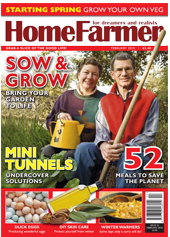 I found this magazine breezing through Tractor Supply this past weekend and bought it because it looked interesting, something I hadn’t seen before. It’s called Home Farmer , and is about small scale farming and homesteading, with a heavy emphasis on backyard livestock. I snatched it up and thumbed through it over the weekend (while Brianne and I were at a sheep auction). When we got home, lambs in tow, it kind of got lost in the shuffle and tasks of settling in a new batch of lambs. But, last night, after designing my new quilt project (and an excellent DVD on Queen Elizabeth) I finally had a chance to dig into it. It is wonderful!
I found this magazine breezing through Tractor Supply this past weekend and bought it because it looked interesting, something I hadn’t seen before. It’s called Home Farmer , and is about small scale farming and homesteading, with a heavy emphasis on backyard livestock. I snatched it up and thumbed through it over the weekend (while Brianne and I were at a sheep auction). When we got home, lambs in tow, it kind of got lost in the shuffle and tasks of settling in a new batch of lambs. But, last night, after designing my new quilt project (and an excellent DVD on Queen Elizabeth) I finally had a chance to dig into it. It is wonderful!
Turns out the reason I wasn’t familiar with it is because it’s a British publication. But I was so excited reading through it because it was like walking around a backyard in England talking about gardens and chickens and farming in small spaces. I’ve spent many weeks in England on vacation and can tell you the British have perfected raising backyard birds. Not to mention the array of gorgeous and fanciful coops. (Check out Forsham.com and Framebow.)
Anyway, my favorite take away from the magazine is how universal homesteading is. This was an English publication, but could easily apply to suburban homesteaders from the beltway of Washington, D.C. to the tract houses of Los Angeles; same birds, same dreams, same understanding; that freedom isn’t in our bank accounts or the cars we drive—it’s right in our own backyards, just past the garden gate.
This is one of my favorite things about suburban homesteading – everyone needs to eat, and we all want to eat a little better, a little fresher, a little more local. To some “better” may mean a better restaurant, but to others it means a hen house and a veggie garden. I’ll always be on the back side of those options, and I’m excited that the later is so well undertaken “across the pond”.
If you haven’t checked out a Tractor Supply store yet, click here to find one in your area
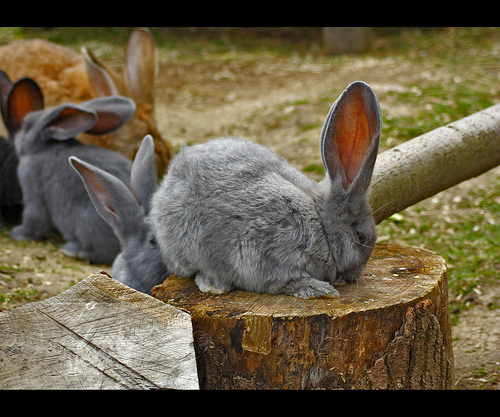

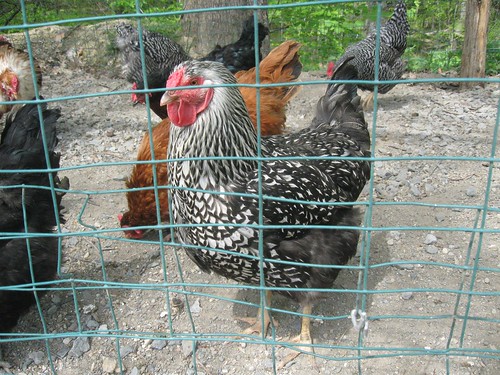


Recent comments
Aenean nonummy hendrerit mauris. Phasellus porta.